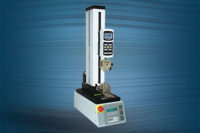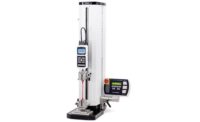Force gage may not be the most familiar term to engineers and quality control professionals. When posed with the question of how to measure force, a load cell may come to mind, or, on the other end of a spectrum, a tensile tester or materials tester. One could be forgiven for not being aware of force gages, as they were relatively basic until the digital revolution changed things dramatically in the 1980s and 1990s. And today, they still serve a unique and subtle purpose that can be difficult to neatly define.
TECH TIPSForce gages are available in a range of capacities and resolutions to accommodate a wide variety of applications. For example, a suture manufacturer may need to measure 50 N of force, while a manufacturer of wire harnesses may need to measure 5,000 N. With any application, a gage should be selected with a capacity that is as close as possible to the maximum expected force. |
What is a force gage?
A force gage can be an end-all-be-all solution for specific tests, or a component of a larger test system. It can be handheld, or integrated into a manual or motorized test stand. Its onboard capabilities make it simple enough for hand operated tests, yet sophisticated enough to integrate with PLCs, data collection software, motorized test stands, and other devices. They are commonly used in research, quality control, and production environments.
Why measure force?
Measuring static compression or tension force yields a wealth of information important in many industries—for example, the opening force of a sealed bag of potato chips, the extension force of a spring, or the pull-off force of a crimped wire terminal. Force data makes it possible to quantify the quality of materials, assemblies or finished products. Proper force testing prevents potentially costly recalls, litigation and customer dissatisfaction in general.
How does a digital force gage work?
At the heart of a digital force gage is a strain gage-based load cell. Strain gages applied to the load cell stretch and retract as a variable force deforms its structure. Deformation of the strain gages changes the electrical resistance in the circuit, thereby correlating force to voltage. This signal is converted into a digital signal, further manipulated by a microprocessor, and converted into units of lbF, kgF, N and other measurement units displayed on an LCD. The load cell is mounted to a metal case sturdy enough to withstand the maximum force rating. Attached to the load cell is a shaft with a threaded end to accommodate attachments, such as hooks, clamps and specialized fixtures.
Selecting an appropriate capacity
Force gages are available in a range of capacities and resolutions to accommodate a wide variety of applications. For example, a suture manufacturer may need to measure 50 N of force, while a manufacturer of wire harnesses may need to measure 5,000 N.
With any application, a gage should be selected with a capacity that is as close as possible to the maximum expected force. Since accuracy is typically specified as a percentage of full range, lower force readings are subject to an increasingly large error as a percentage of reading. For example, if the choice of force gages includes 5, 10, 20 and 50 N capacity models, and the requirement is for 15 N of force, the 20 N model is most appropriate. In general, a force gage should be used between 20% and 80% of its capacity, for best accuracy and margin of safety.
In many applications, the peak force is of most interest, that is, the force at which a sample broke, engaged or loosened. This force is often how manufacturers gage the performance of their product. In other cases, force gages are used to apply a specified force to a sample to determine if the sample remains intact, such as in wire crimp pull testing.
Although force gages may be handheld for less demanding applications, it is considered best practice to mount the gage to a test stand, actuator, or other fixture. This type of mounting reduces the influence due to operator variability, which can lead to inconsistent readings. It also helps to ensure axial alignment with respect to the load cell shaft. Side loading, which can be difficult to avoid during hand testing, can skew the force reading and potentially damage the load cell.
Selecting an appropriate gage model
The variety of force gage models has proliferated over the years, satisfying accuracy, physical size, user interface, outputs and other requirements. More sophisticated gage models have a set of functions that in the past were relegated to more complex testing machines. For example, upper and lower limits can be configured within a force gage. Indicators and tones alert the operator if the result is outside of an established reference range. Set point outputs can trigger an alarm, buzzer, or PLC, for integration into a production or test station.
Beyond simple peak force capture mentioned earlier, continuous data collection is sometimes required for analysis of force vs. time or vs. distance, when combined with an encoder or scale. USB output from the force gage may be used to stream data to a PC for tabulation, graphing, and further manipulation. Continuous analog output can be streamed into a data acquisition system.
Data memory offers users the ability to save individual peak readings for later download, a useful convenience if the measurements are taken in a remote location away from a PC. For special applications requiring the capture of continuous data at high speed, or for data collection over a long period of time, certain gages can acquire such data and store it in memory—thus eliminating the need for data acquisition hardware and software.
Measuring the average force over a period of time is a common requirement in the packaging industry, while the external trigger function accurately captures the force at which a switch activates—two special measurement modes that are available in some gages.
In busy testing environments, high throughput and ergonomics rank high in the list of priorities. Some force gages address these objectives via a footswitch input, for hands-free activation of functions such as data output, data storage and zero display. These types of functions can also be triggered automatically upon detection of a sample break, defined as a percentage drop from peak force. In high volume environments, concerns about improper use or sabotage can be assuaged via password protection.
What can’t a force gage do?
Because test speed and orientation cannot be guaranteed when used by hand, accuracy and repeatability may be lower than when used on a test stand.
Another limitation to consider is position accuracy. If using a force gage in combination with a position encoder to measure force vs. distance, a correction factor must be manually applied. As the force gage’s load cell is compressed or pulled, it deforms. Deformation of 0.010 inch at full scale is typical. If a very stiff sample is tested with total deflection of only 0.050 inch, for example, an offset of 0.010 inch represents a 20% error.
Calibration
Force gages are calibrated utilizing certified dead weights or secondary standards such as load cells with indicators. For gages with capacities of approximately 100 lbF or less, a simple benchtop L-bracket with hook and dead weights are appropriate. For capacities higher than 100 lbF, reference load cells are more widely used, often mounted to a high capacity force test stand. Fine screw pitch on such test stands is helpful for accurate positioning in loading the gage to specific calibration points. Multiple points may be specified during the calibration process, which can help ensure accuracy even when the load cell’s linearity is less than perfect.
The common recommended calibration interval is one year, however, verification of accuracy should be performed more frequently, especially if the gage was dropped or overloaded. Overloads will not always damage the load cell, as they are generally protected to at least 150% of capacity.
Measuring force can quantify the behavior and performance of a product. A force gage is an invaluable tool for manufacturers of materials, assemblies, and finished products in virtually every industry.






